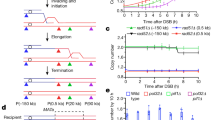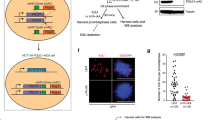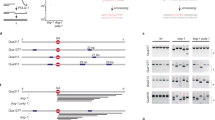Abstract
The repair of chromosomal double strand breaks (DSBs) is crucial for the maintenance of genomic integrity. However, the repair of DSBs can also destabilize the genome by causing mutations and chromosomal rearrangements, the driving forces for carcinogenesis and hereditary diseases. Break-induced replication (BIR) is one of the DSB repair pathways that is highly prone to genetic instability1,2,3. BIR proceeds by invasion of one broken end into a homologous DNA sequence followed by replication that can copy hundreds of kilobases of DNA from a donor molecule all the way through its telomere4,5. The resulting repaired chromosome comes at a great cost to the cell, as BIR promotes mutagenesis, loss of heterozygosity, translocations, and copy number variations, all hallmarks of carcinogenesis4,5,6,7,8,9. BIR uses most known replication proteins to copy large portions of DNA, similar to S-phase replication10,11. It has therefore been suggested that BIR proceeds by semiconservative replication; however, the model of a bona fide, stable replication fork contradicts the known instabilities associated with BIR such as a 1,000-fold increase in mutation rate compared to normal replication9. Here we demonstrate that in budding yeast the mechanism of replication during BIR is significantly different from S-phase replication, as it proceeds via an unusual bubble-like replication fork that results in conservative inheritance of the new genetic material. We provide evidence that this atypical mode of DNA replication, dependent on Pif1 helicase, is responsible for the marked increase in BIR-associated mutations. We propose that the BIR mode of synthesis presents a powerful mechanism that can initiate bursts of genetic instability in eukaryotes, including humans.
This is a preview of subscription content, access via your institution
Access options
Subscribe to this journal
Receive 51 print issues and online access
$199.00 per year
only $3.90 per issue
Buy this article
- Purchase on Springer Link
- Instant access to full article PDF
Prices may be subject to local taxes which are calculated during checkout




Similar content being viewed by others
References
Smith, C. E., Llorente, B. & Symington, L. S. Template switching during break-induced replication. Nature 447, 102–105 (2007)
Deem, A. et al. Defective break-induced replication leads to half-crossovers in Saccharomyces cerevisiae. Genetics 179, 1845–1860 (2008)
Malkova, A. & Haber, J. E. Mutations arising during repair of chromosome breaks. Annu. Rev. Genet. 46, 455–473 (2012)
Malkova, A., Naylor, M. L., Yamaguchi, M., Ira, G. & Haber, J. E. RAD51-dependent break-induced replication differs in kinetics and checkpoint responses from RAD51-mediated gene conversion. Mol. Cell. Biol. 25, 933–944 (2005)
Davis, A. P. & Symington, L. S. RAD51-dependent break-induced replication in yeast. Mol. Cell. Biol. 24, 2344–2351 (2004)
Bosco, G. & Haber, J. E. Chromosome break-induced DNA replication leads to nonreciprocal translocations and telomere capture. Genetics 150, 1037–1047 (1998)
Hastings, P. J., Ira, G. & Lupski, J. R. A microhomology-mediated break-induced replication model for the origin of human copy number variation. PLoS Genet. 5, e1000327 (2009)
Payen, C., Koszul, R., Dujon, B. & Fischer, G. Segmental duplications arise from Pol32-dependent repair of broken forks through two alternative replication-based mechanisms. PLoS Genet. 4, e1000175 (2008)
Deem, A. et al. Break-induced replication is highly inaccurate. PLoS Biol. 9, e1000594 (2011)
Lydeard, J. R., Jain, S., Yamaguchi, M. & Haber, J. E. Break-induced replication and telomerase-independent telomere maintenance require Pol32. Nature 448, 820–823 (2007)
Lydeard, J. R. et al. Break-induced replication requires all essential DNA replication factors except those specific for pre-RC assembly. Genes Dev. 24, 1133–1144 (2010)
Llorente, B., Smith, C. E. & Symington, L. S. Break-induced replication: what is it and what is it for? Cell Cycle 7, 859–864 (2008)
Malkova, A. & Ira, G. Break-induced replication: functions and molecular mechanism. Curr. Opin. Genet. Dev. (2013)
Viggiani, C. J. & Aparicio, O. M. New vectors for simplified construction of BrdU-Incorporating strains of Saccharomyces cerevisiae. Yeast 23, 1045–1051 (2006)
Smith, C. E., Lam, A. F. & Symington, L. S. Aberrant double-strand break repair resulting in half crossovers in mutants defective for Rad51 or the DNA polymerase δ complex. Mol. Cell. Biol. 29, 1432–1441 (2009)
VanHulle, K. et al. Inverted DNA repeats channel repair of distant double-strand breaks into chromatid fusions and chromosomal rearrangements. Mol. Cell. Biol. 27, 2601–2614 (2007)
Fangman, W. L. & Brewer, B. J. Activation of replication origins within yeast chromosomes. Annu. Rev. Cell Biol. 7, 375–402 (1991)
Formosa, T. & Alberts, B. M. DNA synthesis dependent on genetic recombination: characterization of a reaction catalyzed by purified bacteriophage T4 proteins. Cell 47, 793–806 (1986)
Ferguson, D. O. & Holloman, W. K. Recombinational repair of gaps in DNA is asymmetric in Ustilago maydis and can be explained by a migrating D-loop model. Proc. Natl Acad. Sci. USA 93, 5419–5424 (1996)
Yang, Y., Sterling, J., Storici, F., Resnick, M. A. & Gordenin, D. A. Hypermutability of damaged single-strand DNA formed at double-strand breaks and uncapped telomeres in yeast Saccharomyces cerevisiae. PLoS Genet. 4, e1000264 (2008)
Yang, Y., Gordenin, D. A. & Resnick, M. A. A single-strand specific lesion drives MMS-induced hyper-mutability at a double-strand break in yeast. DNA Repair 9, 914–921 (2010)
Roberts, S. A. et al. Clustered mutations in yeast and in human cancers can arise from damaged long single-strand DNA regions. Mol. Cell 46, 424–435 (2012)
Shcherbakova, P. V. & Pavlov, Y. I. 3′→5′ exonucleases of DNA polymerases ε and δ correct base analog induced DNA replication errors on opposite DNA strands in Saccharomyces cerevisiae. Genetics 142, 717–726 (1996)
Chung, W. H., Zhu, Z., Papusha, A., Malkova, A. & Ira, G. Defective resection at DNA double-strand breaks leads to de novo telomere formation and enhances gene targeting. PLoS Genet. 6, e1000948 (2010)
Wilson, M. A. et al. Pif1 helicase and Polδ promote recombination-coupled DNA synthesis via bubble migration. Nature http://dx.doi.org/10.1038/nature12585 (this issue)
Hashimoto, Y. & Costanzo, V. Studying DNA replication fork stability in Xenopus egg extract. Methods Mol. Biol. 745, 437–445 (2011)
Pohjoismaki, J. L. & Goffart, S. Of circles, forks and humanity: Topological organisation and replication of mammalian mitochondrial DNA. BioEssays 33, 290–299 (2011)
Le, S., Moore, J. K., Haber, J. E. & Greider, C. W. RAD50 and RAD51 define two pathways that collaborate to maintain telomeres in the absence of telomerase. Genetics 152, 143–152 (1999)
Kreuzer, K. N., Saunders, M., Weislo, L. J. & Kreuzer, H. W. Recombination-dependent DNA replication stimulated by double-strand breaks in bacteriophage T4. J. Bacteriol. 177, 6844–6853 (1995)
Kuzminov, A. Collapse and repair of replication forks in Escherichia coli. Mol. Microbiol. 16, 373–384 (1995)
Halazonetis, T. D., Gorgoulis, V. G. & Bartek, J. An oncogene-induced DNA damage model for cancer development. Science 319, 1352–1355 (2008)
Wach, A., Brachat, A., Pohlmann, R. & Philippsen, P. New heterologous modules for classical or PCR-based gene disruptions in Saccharomyces cerevisiae. Yeast 10, 1793–1808 (1994)
Guthrie, C. & Fink, G. Guide to Yeast Genetics and Molecular Biology (Academic Press, 1991)
Oh, S. D. et al. Stabilization and electrophoretic analysis of meiotic recombination intermediates in Saccharomyces cerevisiae. Methods Mol. Biol. 557, 209–234 (2009)
Friedman, K. L. & Brewer, B. J. Analysis of replication intermediates by two-dimensional agarose gel electrophoresis. Methods Enzymol. 262, 613–627 (1995)
Goldstein, A. L. & McCusker, J. H. Three new dominant drug resistance cassettes for gene disruption in Saccharomyces cerevisiae. Yeast 15, 1541–1553 (1999)
Conti, C., Caburet, S., Schurra, C. & Bensimon, A. Molecular combing. Curr. Protoc. Cytom. Ch. 8, Unit 8 10 http://dx.doi.org/10.1002/0471142956.cy0810s16 (2001)
Mann, H. & Whitney, D. On a test of whether one of 2 random variables is stochastically larger than the other. Ann. Math. Stat. 18, 50–60 (1947)
Acknowledgements
We thank O. Aparicio for the gift of BrdU cassette plasmid. We thank Y. Pavlov for providing ura3-29 cassette plasmid and P. Chastain and A. Hangaard Andersen for providing us with reagents. We are thankful to D. Gordenin and all members of A.M., K.S.L., G.I. and J.E.H. laboratories for discussions throughout the work. This work was funded by grants from the US National Institutes of Health and National Science Foundation (MCB-0818122 from NSF to K.S.L., and NIH grants R01GM084242 to A.M., R01GM082950 to K.S.L., R03ES016434 to A.M. and K.S.L., GM76020 to J.E.H., and GM080600 to G.I.).
Author information
Authors and Affiliations
Contributions
S.R., N.S., K.S.L. and A.M. designed experiments. S.R. and A.D. constructed the experimental system. N.S., S.R. and R.E. carried out 2D experiments. K.S.L., S.R., A.M., N.S. and Y.Z. carried out molecular combing experiments. S.A., R.E., S.R. and A.D. carried out experiments involving sequencing of BIR-induced mutations. R.E., S.R. and S.A. carried out experiments aimed to determine the effect of BIR on base substitutions. J.E.H. provided key expertise. G.I. contributed to the studies of the role of Pif1 in BIR. S.R., N.S., A.D., J.E.H., K.S.L. and A.M. wrote the paper. N.S. and S.R. contributed equally to this work.
Corresponding authors
Ethics declarations
Competing interests
The authors declare no competing financial interests.
Extended data figures and tables
Extended Data Figure 1 BIR efficiency during molecular combing analysis of molecular intermediates of BIR.
a, BIR efficiency was analysed by PFGE from samples used for dynamic molecular combing analysis (Fig. 3d). DNA was prepared from cells containing truncated chromosome III (Trunc Chr III) before DSB induction and 11 h or 13 h after DSB induction from wild-type (PIF1) and pif1Δ cells, respectively. In pif1Δ, a later time point (13 h) was analysed owing to slower kinetics of DSB repair in pif1Δ as compared to PIF1. Chromosomes were separated by PFGE followed by Southern hybridization with an ADE1-specific probe. b, Quantification of DSB repair efficiency (BIR, or other recombination pathways) based on the results of 3–5 individual experiments and presented as average ± s.d. c, Schematic of the BIR assay. Interruption of BIR leads to the resolution of BIR intermediates resulting in half-crossover formation.
Extended Data Figure 2 Analysis of molecular mechanism and mutagenesis associated with BIR.
a, The summary of molecular combing analysis presented in Fig. 3 and in Extended Data Fig. 3 is shown. A strong bias towards BrdU tracts present only in the recipient chromosome was also observed in three additional independent experiments. b, Mutation spectra of BIR-induced base substitutions in ura3-29 in the presence or absence of 1.5 mM MMS is shown.
Extended Data Figure 3 Molecular outcomes of BIR.
a, Left: interrupted BrdU tract in recipient may result from half-crossover. Right: an example of wild-type (PIF1) recipient with interrupted BrdU tract hybridized to P1, P2, P3 probes (green) and treated with anti-BrdU antibody (red). b, Left: BIR initiated by strand invasion between FS2 (inverted repeat of Ty1 located 30 kb centromere proximal to MAT) and P1 results in formation of recipients hybridizing to P1, P2, P3 and BrdU. Right: an example of wild-type (PIF1) recipient. Top: hybridization to P1, P2, P3. Middle: treatment with anti-BrdU antibody. Bottom: merge. c, Left: BrdU incorporation in the recipient resulting from BIR (red) and from filling-in synthesis (pink) following extensive resection. Right: an example of wild-type (PIF1) recipient. Top: hybridization to P1, P2, P3. Middle: treatment with anti-BrdU antibody. Bottom: merge. d, Left: HJ resolution at the end of BIR progression leads to switch from conservative to semiconservative BIR resulting in a short patch of BrdU overlapping with P3 in the donor. Right: an example of BrdU incorporation in the donor from wild-type (PIF1) strain hybridized to P1, P2, P3 and treated with anti-BrdU antibody.
Extended Data Figure 4 Conservative DNA synthesis associated with BIR.
Results from a series of three experiments where only P1, P2 and anti-BrdU antibody were used. a, BrdU incorporation in the recipient is expected from conservative BIR (i; red) and from filling-in synthesis (pink) following extensive resection (ii). b, c, Analysis of the donor (D) and repaired recipient (R) chromosomes extracted after PFGE (b) and hybridization with probes (green tract) and treatment with anti-BrdU antibodies (red tract) (c). No BrdU tracts are visible in more than 97% of donors. The repaired recipient contains long stretches of BrdU overlapping with the P2 region.
Extended Data Figure 5 BIR kinetics during 2D analysis of molecular intermediates of BIR.
a, BIR kinetics was analysed by PFGE from samples used to determine the structure of BIR intermediates by 2D electrophoresis (Fig. 4c, d). DNA was prepared for PFGE at intervals after induction of DSBs at MAT a and separated by PFGE (a) followed by Southern hybridization with an ADE1-specific probe (b). c, BIR efficiency quantified based on the results of four individual experiments including the one shown in Fig. 4 presented as average ± s.d. d, Flow cytometry of DNA analysis of cells undergoing BIR repair.
Extended Data Figure 6 The structure of molecular intermediates of BIR.
a, The structure of the chromosome III region with LYS2 inserted 16 kb centromere distal to MATα-inc. P1, P2, P3, and so on designate positions of PstI sites flanking LYS2. b, The structure of replication bubbles migrating through LYS2 (with black rectangle designating LYS2-specific probe). i, Replication bubble with synchronous leading and lagging strands (double-stranded). ii, Replication bubble with delayed initiation of the lagging strand with respect to the leading strand (partially single-stranded bubble). iii, A partially single-stranded bubble with one or several PstI sites behind the bubble inactivated due to accumulation of single-stranded DNA. Red and pink rectangles represent oligonucleotides PstO3 and PstO4, respectively. iv, A single-stranded bubble that has passed beyond the P3–P4 region. c, Theoretical bubble-migration curves for the intermediates shown in b. d, Calculation of parameters of the bubble-like structures for the intermediates shown in b.
Extended Data Figure 7 Molecular intermediates of BIR.
BIR intermediates were analysed by 2D gel electrophoresis of BglII-digested intact chromosomal DNA embedded in agarose plugs. a, D-loop migration in 2D gels (hybridized to LYS2, black rectangle) during coordinated (i) and uncoordinated (ii, iii) leading- and lagging-strand synthesis. b, Schematic of 2D gel separation of replication and BIR intermediates. Annealing to oligonucleotides (BglO3 and BglO4) restores BglII sites (B) in ssDNA (see a, ii) and changes migration of the intermediate as shown by 2′ (red). c, 2D analysis of Y-arc during normal replication (0 Hr) and bubble-like structures at time points after BIR induction. Similar bubble structures were observed in nine additional independent experiments (see the legend to Fig. 4). d, High-molecular-mass tails (arrows) disappear after simultaneous addition of BglO3 and BglO4 (BIR/BglO3+BglO4). The addition of each of these oligonucleotides individually (BIR/BglO3 or BIR/BglO4) failed to eliminate the tail.
Supplementary information
Supplementary Information
This file contains a Supplementary Discussion. (PDF 233 kb)
Rights and permissions
About this article
Cite this article
Saini, N., Ramakrishnan, S., Elango, R. et al. Migrating bubble during break-induced replication drives conservative DNA synthesis. Nature 502, 389–392 (2013). https://doi.org/10.1038/nature12584
Received:
Accepted:
Published:
Issue Date:
DOI: https://doi.org/10.1038/nature12584
This article is cited by
-
Pathway choice in the alternative telomere lengthening in neoplasia is dictated by replication fork processing mediated by EXD2’s nuclease activity
Nature Communications (2023)
-
Structure-forming CAG/CTG repeats interfere with gap repair to cause repeat expansions and chromosome breaks
Nature Communications (2023)
-
The mechanism of replication stalling and recovery within repetitive DNA
Nature Communications (2022)
-
Tracking break-induced replication shows that it stalls at roadblocks
Nature (2021)
-
High-resolution mapping of mitotic DNA synthesis regions and common fragile sites in the human genome through direct sequencing
Cell Research (2020)
Comments
By submitting a comment you agree to abide by our Terms and Community Guidelines. If you find something abusive or that does not comply with our terms or guidelines please flag it as inappropriate.



